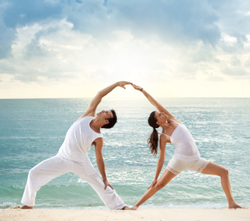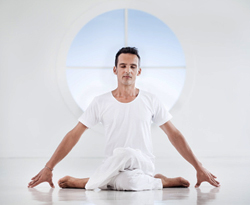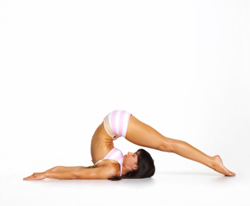Fundamental principles in the practice of ASANAs applying to all adepts of the HATHA YOGA system
• Evoking the communion and unity of our being’s Microcosm with the whole Macrocosm. In order to do that we can use the following beneficial force-idea: “my whole physical and subtle being is perfect and harmonious; I am one with the Macrocosm manifested through billions of names and forms. I am always full of kindness for those around me and I generously help them when they are in need.”
Evoking the communion and unity of our being’s Microcosm with the whole Macrocosm. In order to do that we can use the following beneficial force-idea: “my whole physical and subtle being is perfect and harmonious; I am one with the Macrocosm manifested through billions of names and forms. I am always full of kindness for those around me and I generously help them when they are in need.”
•Focus on your own being and practice HATHA YOGA full of conscientiousness. Aspiration, fervor.
•Wisely used effort; attention, calm, vigilance.
•Firm concentration on one specific body area or function, on certain specific elements of practice or on the body’s immobility.
•Becoming conscious of the existence of the two phases of each ASANA: the passive and the active one.
•Relax the body, psyche and mind before and after practicing an ASANA and simultaneously perceive and assimilate the subtle energy specific to that ASANA through occult resonance.
•The necessity of warm-up techniques practice before beginning the HATHA YOGA session.
•Strictly respect the order of ASANAs.
vSetting a predetermined way of adequate breathing before practicing one ASANA.
•Detachment, no exaggeration, no competition.
•The practice of ASANAs has to be made with perseverance but without competition. In itself HATHA YOGA is a lifestyle completely different from the modern way of life. Even when some yoga aspirants cannot practice perfectly the body postures in the beginning of the practice due to some physical limitations, the practice of yoga postures always has a beneficial psychosomatic effect if the awareness is focused accordingly on the execution and if certain fundamental principles are respected:
 •During ASANA practice we will try to see each body attitude we take as an open gate for the revelation of the Immortal Self ATMAN’s profound spirituality.
•During ASANA practice we will try to see each body attitude we take as an open gate for the revelation of the Immortal Self ATMAN’s profound spirituality.
•It is recommended to practice HATHA YOGA in a well-aired secluded and quiet place. The soil on which you practice should not be too tough or too soft (it is recommended to practice HATHA YOGA on a folded-in-two or four yoga towel or yoga mat of an adequate dimension); this way you will avoid the discomfort or pain in some body areas.
•During the whole HATHA YOGA session it is recommended to breathe through the nose (excepting the techniques that require otherwise). Also we will keep our eyes closed in order to better focus on ourselves. It is also recommended to end the ASANA session with one or more inverted body postures followed by deep relaxation and a short meditation.
•Each ASANA practice should include four distinct phases: preparing the execution, the proper execution, maintaining the body posture for long enough, adapting the initial beginning pose and becoming aware of the subtle specific effects.
•If the practitioner cannot practice correctly or at all a certain body posture because of a physical handicap it is recommended to use the creative visualization: he/she will mind-imagine the desired yoga posture with clarity as if it’s already successfully practiced.
•The deep understanding of using non-violence (AHIMSA) as a necessity applied in every life situation. It attracts the state of calm and inner peace.
 •The ASANA session has to be integrated at the right moment in relation to other HATHA YOGA practice elements (such as PRANAYAMA – control of breathing; MUDRAs – specific gestures that intermediate the resonance with specific gigantic Macrocosm energies, BANDHAs – specific contractions using certain areas of the body etc.).
•The ASANA session has to be integrated at the right moment in relation to other HATHA YOGA practice elements (such as PRANAYAMA – control of breathing; MUDRAs – specific gestures that intermediate the resonance with specific gigantic Macrocosm energies, BANDHAs – specific contractions using certain areas of the body etc.).
•Relaxing all body areas either they contribute in the specific body posture that we practice or not. Let’s always remember that the real progress in HATHA YOGA practice comes when the techniques and methods are practiced in a state of calm and deep relaxation.
•Each technique and yoga exercise has to be accompanied by a corresponding mind focus that allows us to become aware of the effects that happen then in our being.
Fragment from the book HATHA YOGA for beginner and advanced yogis full of aspiration by Swami Mahasiddhananada.
yogaesoteric
march 2016


